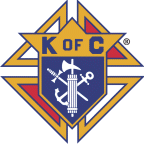Knights of Columbus Council 3282 Chartered

In the 1940s a group of local men, parishioners of St. Henry's under the tutelage and encouragement of Knights from neighboring Cairo, Illinois, Council 1027, became interested in the Knights of Columbus. Upon invitation they joined, and began attending meetings in Cairo. The numbers attending grew enough to consider forming our own local Knights of Columbus council.
On February 19, 1950, Knights of Columbus Charleston Council 3282 received its charter from Knights of Columbus Supreme Council in New Haven, Connecticut. In the beginning the gentlemen would meet above Ben Stricker's garage down Court Street a block west of the church. Within very few years the council began looking for a more permanent home.
A lot became available at 303 South Sixth Street on the northwest corner of Sixth and Danforth Streets. The council purchased the lot, and by the mid-1950s had erected a fine meeting and banquet hall there, utilizing much volunteer talent possessed by the men of the council in its construction. That building continues to serve the needs of the council to this day [2012].
In February, 2004, Mr. R. David White spoke at the Knights of Columbus Family and Fraternal Dinner about the early founding of the local council. R. David typed his message, as follows, and asked that it be published in order to edify others who may come later:
A SYNOPSIS OF AN ADDRESS MADE AT THE ANNUAL (2004) DINNER OF THE KNIGHTS OF COLUMBUS COUNCIL 3282 FOR MEMBERS, WIVES, & FAMILIES.
Delivered by R. David White
"WHAT CAN ONE PERSON DO?"
Some sixty years ago I was running a grocery store here in Charleston. Grady Claycomb was a salesman for Swoboda Grocery Co. in Cairo, IL, and he called on me. After some time had passed he asked me if I would be interested in joining the Knights of Columbus at Cairo, since there was no KC organization here. He suggested that I get a few members of St. Henry's that might be interested and he would meet with us and explain what the KC's were all about and eligibility.
I contacted the following persons: Paul B. Stricker, Herman Hart, George Lankheit, Frank Baudendistel, and Tom Bennett and we met with Grady and two other members from Cairo and they explained the programs and what the KC's was all about. We were well pleased with the information and joined the Cairo council.
As time went by more and more members of St. Henry's became interested and joined and soon there were enough of our local people to be eligible to form a council here in Charleston and then Council 3282 came to be.
I am not going into details as to what benefits this council has been to St. Henry's Church and School as well as to the community. They were both monetary and good of the community benefits.
Now I'm not naive enough to believe or try to make you believe that had it not been for Grady Claycomb this council would never exist, but he did sow the seed and it took root and sprouted and eventually branched out to embrace Council 3282. Grady had an opportunity that very few persons have, but he seized the opportunity and fulfilled it. We should ask ourself this question (What as one person can I do?).
James Fennimore Cooper wrote a novel called The Last of the Mohicans about a tribe of Indians that inhabited our land, and without going into details of the whole story I am only going to dwell on the last words of the book. This old Indian was standing on a mountain and looking over the valley that was once the tribe's territory he said to two people accompanying him "My people are all dead." Then he waited a few moments and said "I am the last of the Mohicans." No doubt this was a very sad moment for him.
Now I am not the last of the knights, but I am the last of the original group: but as long as we have members who have the will and the determination, Council 3282 will endure and survive. Thank you.
- R. David White, February, 2004

